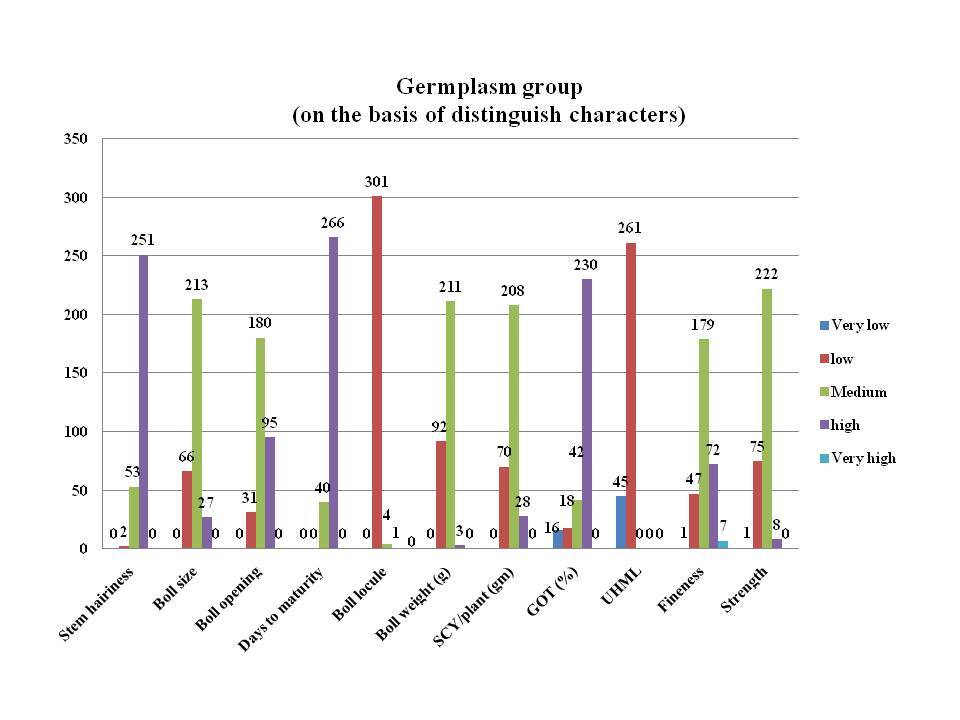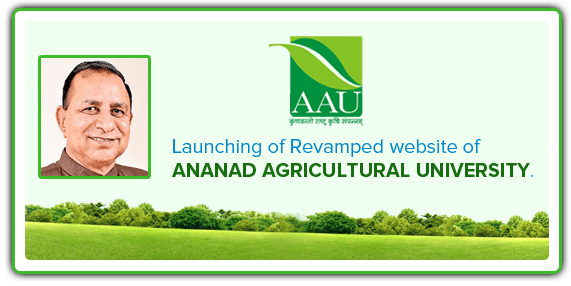Search
Unit Menu
Latest News
Regional Cotton Research Station, Viramgam
Research Recommendation (Approved in Joint AGRESCO)
|
Sr.no. |
Crop /released variety |
Year of released |
Average Yield kg/ha. |
Yield potential |
Remarks |
|
Cotton |
|||||
|
1 |
Wagad -8 |
1930 |
564 |
-- |
Closed boll type |
|
2 |
Wagotar |
1934 |
649 |
-- |
Closed boll type |
|
3 |
Kalyan |
1947 |
751 |
-- |
Closed boll type |
|
4 |
V 797 |
1966 |
1035 kg/ha |
1600 kg/ha |
Closed boll type |
|
5 |
G cot 13 |
1981 |
1072 kg/ha |
1650 kg/ha |
Semi open boll type |
|
6 |
G cot 21 |
1998 |
1202 kg/ha |
2000 kg/ha |
Semi open boll type |
|
7 |
ADC 1 |
2010 |
1306 kg/ha |
2100 kg/ha |
Semi open boll type |
|
8 |
GADC 2 |
2015 |
1640 kg/ha |
3424 kg/ha |
Semi open boll type |
| 9 | Wagad Gaurav (GADC 3) | 2019 | 2150 kg/ha | 3088 kg/ha | Semi open boll type |
| 10 | Wagad Resham (GADC 4) | 2020 | 1313 kg/ha | 1962 kg/ha | Open boll type with excellent fibre quality |
|
Sorghum |
|||||
|
1 |
C 10-2 |
1942 |
4675 kg/ha Dry Fodder 537 kg/ha Grain |
- |
For fodder purpose |
Recommendations for farming communities:
|
SN |
Recommendations |
|
1 |
Effect of spacing, nitrogen levels and biofertilizer on yield of desi cotton variety Wagad Gaurav under rainfed condition (2024)
The farmers of North-West Agro-climatic Zone and Bhal & Coastal Agro-climatic Zone growing rainfed desi cotton (GADC 3) are recommended to treat the seed with bio NPK consortium (10 mL/kg) keeping sowing distance either 120 x 30 cm or 180 x 45 cm and apply 40 kg N (two equal splits at 25-30 DAS and 50-60 DAS) to get higher seed cotton yield and net return. |
|
2 |
Effect of paired row sowing on yield and fibre quality of desi cotton under rainfed condition (2022)
The farmers of North-West Agro-climatic Zone and Bhal & Coastal Agro-climatic Zone growing rainfed desi cotton are recommended to sow cotton in paired row of 30-180-30 cm and plant to plant distance 30 cm apart to get higher seed cotton yield and net return. |
|
3 |
Effect of limited irrigation on production and fibre quality of desi cotton (2021)
The farmer of North-West Agro-climatic Zone growing desi cotton under limited irrigation are advised to irrigate one irrigation at 20 days after withdrawal of monsoon to get higher seed cotton yield and net return. |
|
4 |
Standardization of crop spacing and its effect on yield and fibre quality of desi cotton under rainfed condition (2019)
The farmers of Bhal and coastal agro-climatic zone growing rainfed desi cotton are advised to sow cotton variety G Cot 21 at 60 x 30 cm spacing to get higher seed cotton yield and net return. |
|
5 |
Assessment of organic farming and inorganic nutrient supply system on yield and quality of cotton variety G Cot 21 (2014)
The farmers of North-West Agro-climatic Zone-V growing rainfed cotton are advised to apply 100% N through FYM (8 t/ha) or 75% N through fertilizer (30 kg N/ha) + 25% N through vermicompost (600 kg/ha) to get higher seed yield and net return. |
|
6 |
Study on plant density and levels of Nitrogen of new released herbaceum cotton variety Anand Desi Cotton-1 (2014)
The farmers of North-West Agro-climatic Zone-V growing rainfed deshi cotton variety ADC-1 are advised to sow the crop at 210 cm x 30 cm spacing and fertilize @ 40 kg N/ha (20 kg/ha as basal and 20 kg/ha as top dressing at 30-40 DAS) to get higher seed cotton yield and net return. |
|
7 |
Permanent small plot trial for studying the long term effect of Phosphorus on the yield of herbaceum cotton under rainfed conditions (2014)
The farmers of herbaceum cotton growing area of North-West agro-climatic zone-V are advised not to apply phosphorous in rainfed herbaceum cotton as it did not significantly affect the seed cotton yield. |
|
8 |
Effect of method of irrigation and nitrogen levels on growth and yield of G Cot 21 (2010)
The farmers of North-West Agro-climatic Zone (Wagad Zone) are advised to irrigate cotton crop through alternate furrow at flowering and boll formation stage and also fertilized the crop with 80 kg N/ha in two equal splits at 25-30 DAS and DAS 50-60 to get higher seed cotton yield and net realization (BCR 2.99). |
|
9 |
To study the feasibility of inter cropping in cotton variety G Cot 21 under rainfed conditions (2010)
The farmers of North – West Agro climatic Zone (Wagad Zone) are advised to grow cotton crop (var. G Cot 21) at wider distance (either 2.10 x 0.30 or 2.40 x 0.30 m) with one row of inter crop planting of Green gram (var. GM – 4) or Black gram (var. T-9) to get higher equivalent seed cotton yield and net realization. |
Germplasm
The Centre has been maintained total three hundred two germplasm lines of desi cotton (G. herbaceum) and some of them were collected before independence. The characterization has been completed of all germplasm lines for thirty seven characters during 2016-17 & 2017-18. On the basis of two years average phenotypic data, the results are shown in graph.

Note: Data on bar shows number of accessions falls under respective group of particular characters.

